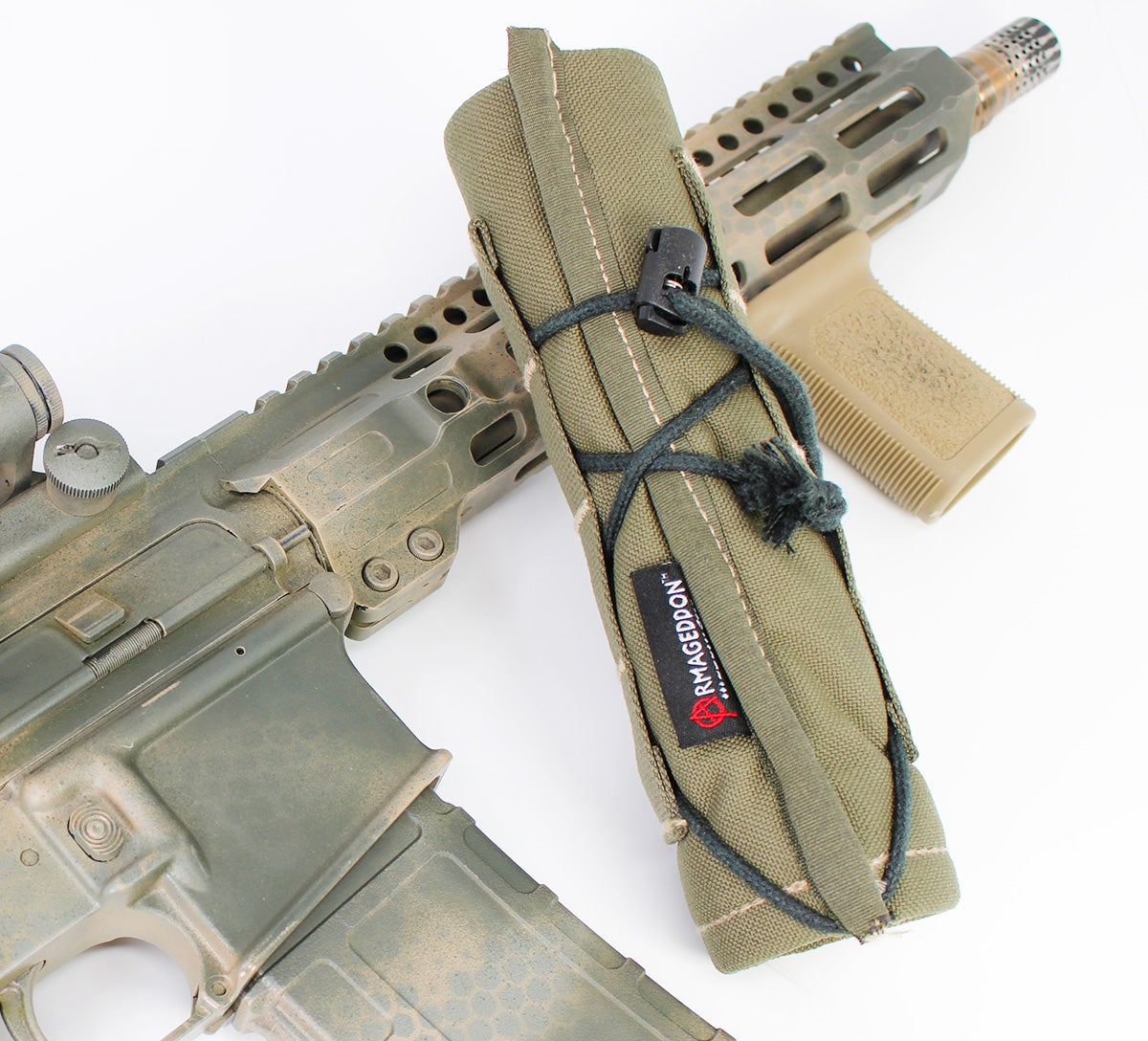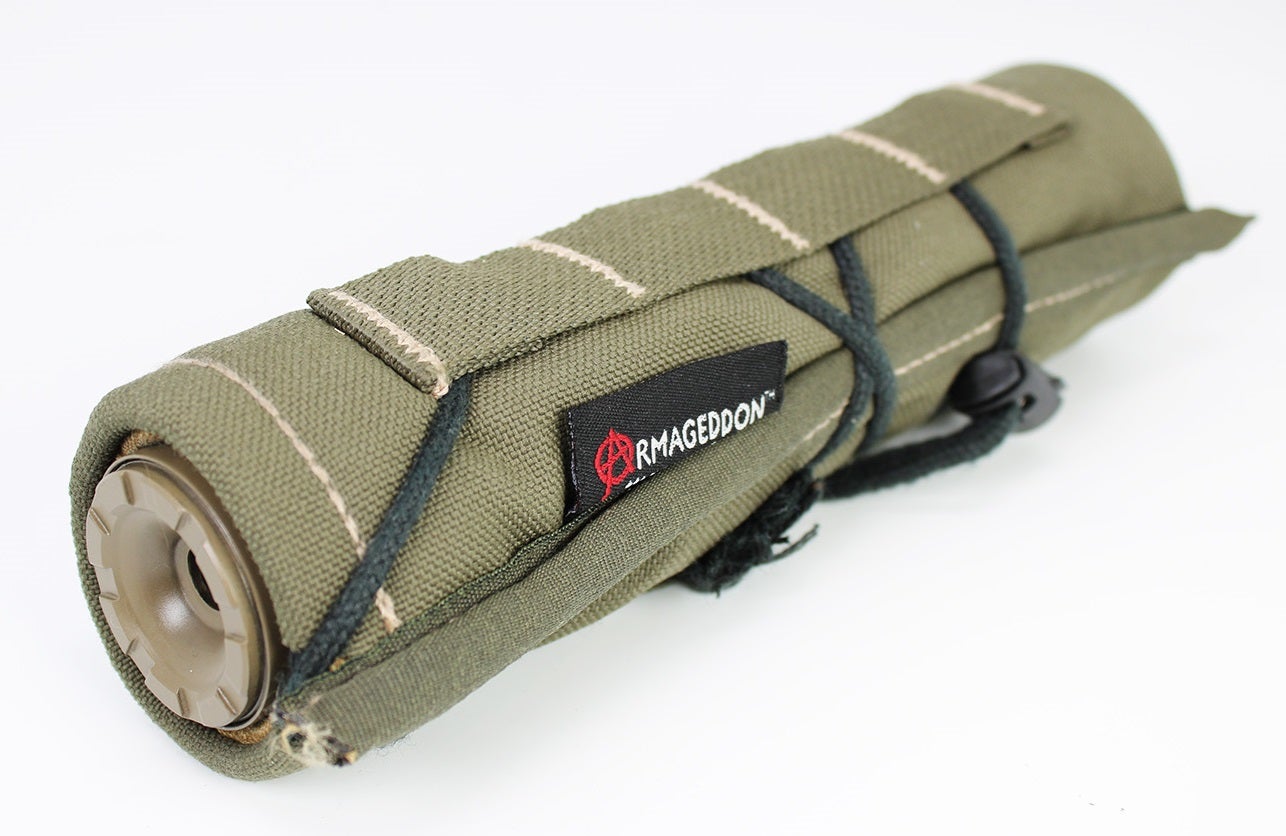Own a Suppressor? You Need a Suppressor Cover
Travis Olander 12.27.22

Take it from me: The first time you accidentally touch flesh to hot titanium, you’ll be cursing for hours – and wishing you’d just spent that bit of cash on a suppressor cover. Let’s take a look at the top options and weigh their pro’s and con’s. I’ll recommend my personal favorite cover for my 300 Blackout can, too.
What is a Suppressor Cover?
Suppressor covers are made from high-temperature materials that wrap around the body of your can. These covers are made of different fire-retardant materials, and most are capable of withstanding some crazy heat: Up to 800 degrees (F) or more.
Why Bother With a Cover?
Besides the obvious “tacticool” factor and extra aesthetics, there are plenty of practical reasons you should invest in one of these covers.
1. Personal Protection
Above all else, a suppressor cover protects you from serious burns. This writer knows it, too. I’ve sent enough 30-rounders through my 300 Blackout-chambered SBR to have just one wayward brush of a knuckle up against my can’s titanium housing. Once. That’s all it took for me to howl in anger, suffer a nice welt on my thumb for a few days, and vow to never get bit by extra spicy Grade 9 Ti again.
If you’re new to owning a muzzle muffler, you might not have put it through some real paces, yet. But rest assured, even a dozen or so “mild” or subsonic rounds down the tube is enough to go from ambient temperature to sizzlin’ bacon. That means instant burns should you accidentally touch the tube for a split second.
2. Easy Removal
We’re always excited to thread on the can and start shooting, right? But it’s easy to forget that once you’re done shooting, you’ve got to safely remove and stow that suppressor. Trying to remove a bare tube post-range-hot is practically impossible — again, lest you wind up with serious burns.
And it’s no fun sitting around, waiting for a metal brick to cool off before you can safely tuck it away in your gun case or backpack. The cover helps insulate against ruining your gear while the tube cools off.
3. Mirage Mitigation
This is something often overlooked, unless you’ve purposefully abused a barrel while sighting down an optic: When suppressors heat up, they create a mirage effect in front of your glass. It easily disrupts your sight picture and targeting. A suppressor cover disperses heat and prevents this from occurring.
4. Fire Risk Mitigation
This writer’s seen at least one instance of a fellow shooter carelessly resting his suppressor atop a rubberized range bench, only to find that bench’s cover melted after it started smoking. Suppressors get hot enough to cause a contact fire, especially if you’re in the outdoors, hanging out in some dry grass. Maybe you’re shooting from the prone, focusing on aiming. Only once you start seeing smoke do you realize you just started a brush fire. Yet again, a suppressor cover drastically reduces this risk.
So, which covers are best at ticking all four of these boxes? Let’s compare.
Types of Suppressor Covers
1. Silicon Sleeves
Pictured: 7″ ribbed silicon cover from Manta Defense
Silicon suppressor covers are best reserved for low-velocity or light applications. They’re great for any rimfire rifle. I say this because although silicon is frequently used for high-temperature applications (like engine and coolant gaskets) it just doesn’t yield the level of performance needed for most hot muzzle mufflers.
Silicon covers can withstand up to 500 or 600 degrees (F), which means generally shooting at a slow pace. The downside to these covers is what happens if you exceed their limits: They melt. Often, they’ll wind up requiring some peeling and prying, which can damage whatever finish is on your can. The advantage of silicon covers is their size. They tend to provide a snug fit with relatively thin material.
2. Fabric Wraps
Pictured: Armageddon Gear Extreme High-Temp Cover
High-temperature fabric covers are the current trend, and it’s what I use on my suppressed 300 BLK. The inner liner of fabric covers is typically made from fiberglass or Kevlar. The outer layer often sports a pattern or color, and is usually made from temperature-resistant Cordura or a similar ripstop fabric.
These covers can withstand temperatures of 800 degrees (F), and they perform well during rapid fire. I’ve dumped at least three 30-round mags in a row through my cover, and it show no hint of melting or smoking. These covers are a bit thicker than silicon covers, but they perform much better and can be more easily installed, removed, and tightened down with drawstrings.
3. Polymer and Metal (2-in-1) Covers
Pictured: Magpul Polymer/Stainless 5.5″ Cover
Now we’re getting serious: These covers can withstand automatic fire and often advertise temperature ratings of 1,800 degrees (F) or more. These covers use an inner stainless steel liner with built-in spacers to allow for airflow across the surface of the can. The steel gets hot either way, so a second, high-temperature polymer skin is applied over top.
Together, these 2-in-1 covers can provide hours’ worth of heat mitigation without failure, and they’re nearly as safe and easy to remove as a fabric cover. The downside is their cost and compatibility, and size.
These covers are more expensive than any other option. And because they’re made from machined steel, they can be bulky and heavy. Plus, you’ll need to find a manufacturer that produces one for your can’s diameter and length.
(You Still Need to Be Careful)
Even my super-high-performance fabric cover gets uncomfortably hot after a few mild magazines. Always use caution when you’re about to grab that covered can. Give it a quick fingertip test, or splash a bit of water on it. If you hear sizzling or see steam, give it a rest before trying to remove the can or cover. Need a new suppressor to heat up and abuse? Check out our review of the HUXWRX new “CA$H 9K”. It’s optimized for seriously shushing 9mm loads.


